If the sag has been set up correctly but the coil/oil fork keeps bottoming out—the fork reaches the full extent of its travel but the spring cannot compress any more—it will be necessary to fit heavier-duty springs. Conversely, if the fork only reacts to the bigger lumps and bumps, lighter springs should be fitted.
The method of changing springs is similar in most coil/oil forks, but check the manufacturer’s manual to find the features of the fork on the bike in question. It may not be necessary to remove the fork blade from the fork crown; or a spring in both blades of the fork may need replacing; or one blade may incorporate the spring, while the other has the damping mechanism.- Google listing of all "Suspension, Coil, Oil" stuff on our site
- Yahoo! listing of all "Suspension, Coil, Oil" stuff on our site
- AltaVista listing of all "Suspension, Coil, Oil" stuff on our site
Tools Needed:
- Wrench
- Allen key multi-tool
- Flat screwdriver
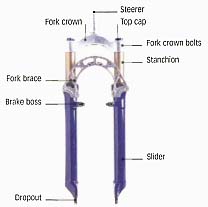
Parts of a coil/oil fork
Fork brace; Brake boss; Dropout; Fork crown; blade; Steerer Top cap; Fork crown bolts; Stanchion; Slider
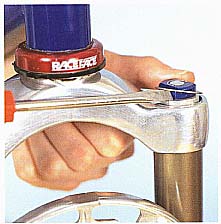
Setting Sag
1. Remove the circle clip from around the rebound adjuster of the fork by prying it off with a flat screwdriver. Be very careful. Do not dig your screwdriver too far under the circle clip, but put it far enough under so that it does not slip. Keep your fingers away from the screwdriver to avoid injuring yourself if it slips.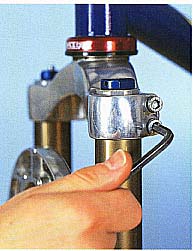
2. Undo the retaining bolts in the fork crown so that you can drop the blades out. There are usually four retaining bolts. Some fork crowns do not have them, in which case undo a cap bolt at the top of the fork blade to remove the springs.

3. Start to remove the top cap of the fork blade with a wrench on the wrench flats, then unscrew the cap the rest of the way out with your fingers.
- Note how the spring is sitting in the fork blade, then lift the spring out.
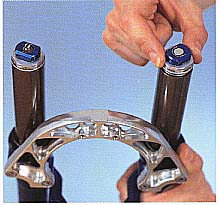
4. Drop the new spring into the fork blade. Make sure that it sits correctly in the fork blade, then replace the top cap.
- Screw the top cap in with your fingers, then tighten it with a wrench.
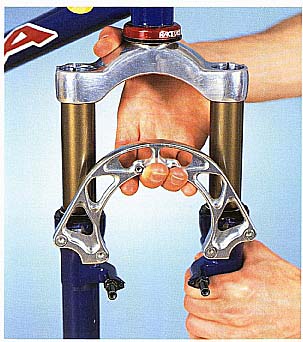
5. Put the fork blades back in the fork crown and secure the retaining bolts.
- Follow the manufacturer’s torque settings when replacing the retaining bolts.
- Reset the sag of your forks.
